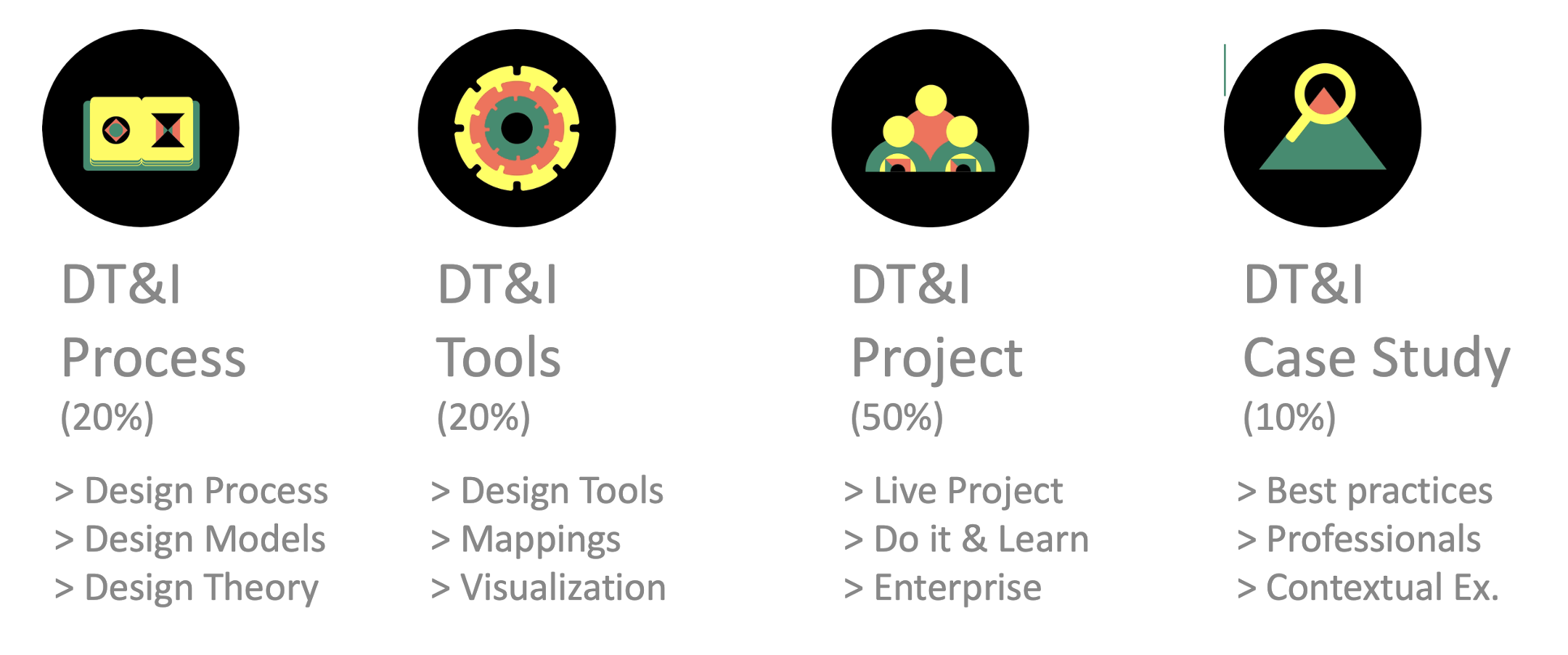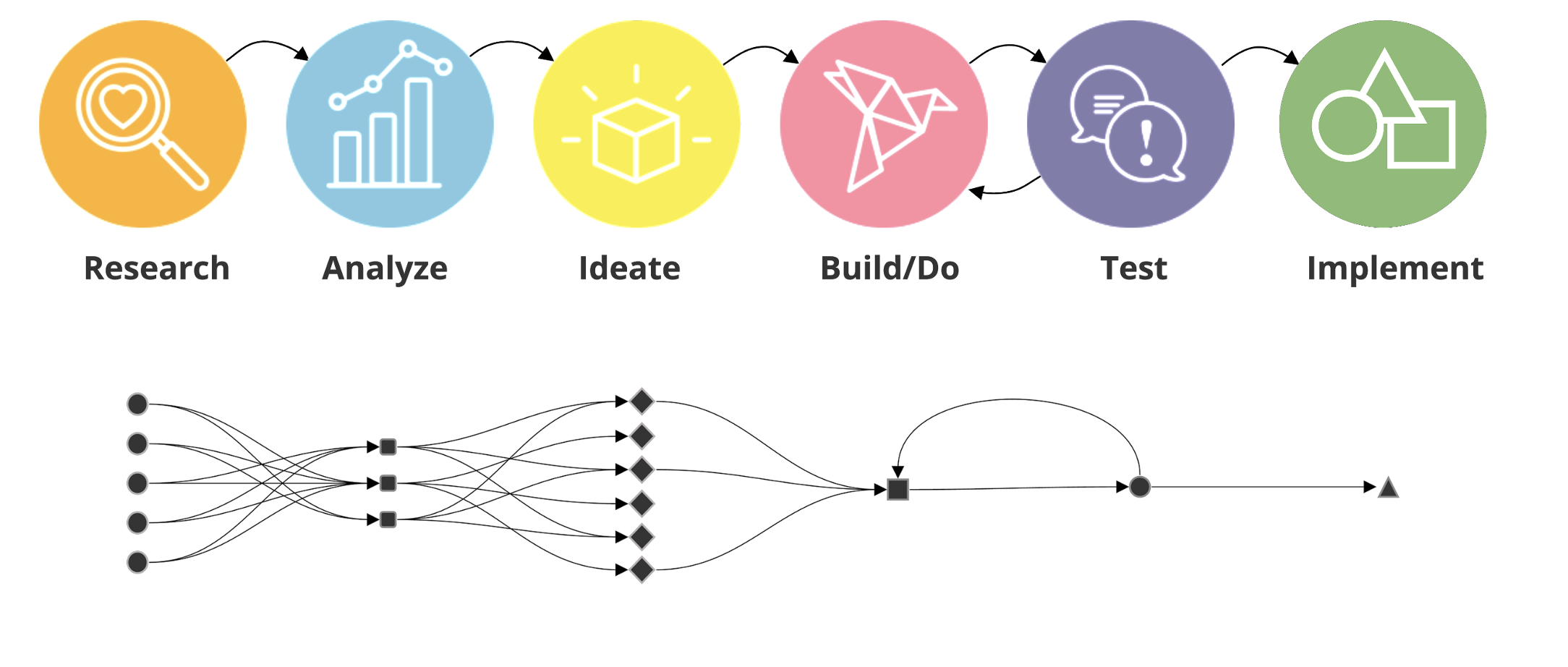
Design Thinking and Innovation for Higher Education:
WHAT WHO HOW WHEN
The course on ‘Design Thinking and Innovation’ is curated and presented by Professor Ravi Poovaiah, senior faculty member at IDC School of Design, IIT Bombay.
The course will be of 4 credits, with 4 modules every week for 16 weeks, available on the Swayam platform starting from 15th of July 2024 onwards.
Each week will cover:
(a) Process that includes Theory and Methods,
(b) Tools that will help you solve the problem,
(c) Design Project that will be hands-on using the Design Thinking and Innovation process, followed with
(d) Case Studies of Design and Innovation projects by Faculty members and Professionals.
WHAT:
What is Design Thinking and Innovation (DT&I)?
One can understand Design Thinking as a method to solve problems using a process that is structured and systematic. It is one of the most effective ways to create something new. A process that first understands users, identifies and analyses a problem or need, and researches relevant information, after which ideas are explored and analyzed, until an appropriate innovative solution to the problem or need is arrived at. Hence Design Thinking could be viewed as the process that translates an idea into a blueprint for something useful, whether it's a vehicle, a building, a graphic, a service or a system.
In a nutshell, Design Thinking along with Innovation, combines user requirements, finds creative solutions, explores suitable technology alternatives, and results in a new business enterprise or solves existing problems for an organization
The Design Thinking process can be applied to solve problems and find creative innovative solutions in any field or domain. For example, you could apply Design Thinking to solve problems in arts, social sciences, law, medicine, engineering, business, etc. It could even be applied to solve problems at home or in your neighbourhood or your place of work. Whether it is a simple problem or a complex problem, a design thinker finds creative ways to tackle them. If everyone could adopt this method to solve problems then we would be moving towards a creative society that finds solutions to many of its problems.
What are the aims of Design Thinking and Innovation Course?
The Design Thinking and Innovation course will help students Identify problems and be able to find solutions and apply Design Thinking processes and methods to solve various problems. The course will help students learn the fundamentals/essentials of the Design Thinking and Innovation process. The students will solve live contextual problems such that it creates awareness in the students through observation, discovery, analysis, experience, collaboration and reflection. The intention is to nurture their curiosity and enhance their explorative abilities and be able to apply it to foster creativity and innovation in students in any field. The students will also be able to realize their ideas as prototypes, test it and get feedback from users so that they can iteratively improve their solutions.
WHO:
Who should attend this course?
The course is meant for:
(1) Students of higher education (both under graduate and post graduate students)
(2) Faculty members at both schools and colleges who would like to understand this subject,
(3) Professionals in any field who would like to explore creative possibilities in their respective areas of expertise and
(4) Entrepreneurs.
The backgrounds of Students, Faculty members, Professionals, and Entrepreneurs could be from Arts, Science, Humanities, Engineering, Law, Medicine, Architecture, Design and other disciplines.
Note for Entrepreneurs: The course will be useful for Entrepreneurs who would like to improve their business and are seeking new opportunities and methods to do it. It could be to develop new innovative products or applications, improve their services in novel ways, or to find a solution to an existing problem. These could include SMSE's, Tech Start-ups, Social Innovators, Rural Entrepreneurs, etc.
Should you opt for this course?
Design Thinking and Innovation will assume an ever more important role to play in the future of our world. This will help address, identify and solve problems creatively whatever the field of specialization. It should be useful to find solutions to issues both within one's own contexts and to issues at a national or global level. It will also be a useful tool for us to move towards a creative economy in the coming years.
So if you would like to be part of this creative innovative practice, do opt for this subject.
HOW:
How is the Design Thinking and Innovation course learnt?
The Design Thinking and Innovation course has 4 sections for each of the weekly sessions or modules:
1. DT& I Process
2. DT& I Tools
3. DT&I Project
4. DT&I Case Studies

Method of Learning:
- Exposure to different aspects and stages of thinking process
- Solving an identified problem in phases across the 16 weeks (involving the DT&I process and tools)
DT&I Process:
Steps to Creativity and Innovation:
DT& I involves the following six phases in the process of solving a problem:
Phase 1. Research/Observe/Empathize
- Conduct secondary research on existing knowledge and Primary research based on user studies
- The first phase helps you to identify needs and locate issues to be solved through observation and empathy
Phase 2. Analyze/ Understand/Define
- The second phase of the process helps you to understand, define and analyse the problem area
- Analysis of problem with relational mappings and visualizations
Phase 3. Ideate/Alternate/Create
- The third phase helps you to come out with several alternate creative innovative solutions to the problem
- Creativity, Ideation and Innovation - generating alternate concepts
Phase 4. Build/Prototype/Detail
- The fourth phase helps you to actualize the solution by building mock-ups, creating scenarios, and then prototyping and detailing
- Final Prototyping Methods with Interface, form and technology details
Phase 5. Test/ Feedback/Reflect
- The fifth phase is to get feedback through evaluation so that the suggestions can be iteratively included in the final solution.
Phase 6. Business Model and DT&I Project Presentation
- The last sixth phase is to prepare a business plan, start an enterprise or an industry and implemented in the final solution. The report along with the presentation needs to be submitted as part of documenting the project outcome.

DT&I Tools:
Exposure to knowledge of Tools for Design Thinking and Innovation:
The program will expose the students to the state-of-art tools to be used as part of the Design Thinking and Innovation problem solving process. The tools are useful in all stages of the design process.
Listing of some of the Tools:
Phase 1: Brain-storming, Mind-mapping and Affinity-mapping, SWOT analysis, Contextual Inquiry, Ethnographic Tools, User Mappings, etc.
Phase 2: Activity Mapping, Space – Time Mappings, Artifact Mappings, Concept Maps, Personas, Causal Diagrams, Giga System Maps, Life-Cycle Mapping, Journey Mapping, etc.
Phase 3: Brain-storming, Body-storming, Lateral Thinking, Synectics, Removing Mental Blocks, SCAMPER, Rapid Idea Sketching, etc.
Phase 4: Paper Prototype, Soft Prototyping, Human Factors Analysis, Information Architecture, etc.
Phase 5: Hi-fidelity prototypes, 3D Modeling and Printing, Detailing, Scenarios, User Feedback Methods, Usability Studies, etc.
Phase 6: Business Models, Presentation Methods, Report Etiquettes
DT&I Project:
Project Based hands on learning Process:
The course will be based on hands-on project based learning where the students will identify and find innovative solutions to a live contextual problem as an open design challenge.
The understanding of DT& I process, use of Design Tools for analysis and exposure to Case Studies will happen simultaneously.
DT & I project is done during the duration of 16 weeks of this course making use of the different phases of the design process in solving the given problem
Project as an Open Design Innovation Challenge:
For the Project Topic, every year, Real-Life Problem Areas (India focused as an open design challenge) would be identified based on contextual needs and given at the beginning of the course. Each of the participants get to choose an issue from these Problem Areas and solve it using the Design Thinking and Innovation process over the next 16 weeks.
DT&I Case Study:
Exposure to Case Studies and Experts:
The exposure content will have theoretical and practical inputs from experts in this field as well as experienced professionals from the industry along with exposure to case studies of projects using Design Thinking and Innovation.
WHEN:
Duration and Sessions:
Duration of the proposed course: 16 weeks
Number of sessions per week: 4
Duration of sessions per week: 1-3 hours
DT&I Project duration: 16 weeks
Expected time to be spent on DT&I project every week: 4-6 hours
Total credits: 4 Credits
Details:
Number of sessions: | 16 x 4 over 16 weeks |
Exposure to DT&I Process: | 30 minutes |
Knowledge of Tools for DT&I: | 15 minutes |
DT&I Project Steps: | 15 minutes |
DT&I Case Study example: | 30 minutes |
Total duration per week for sessions: | 1.5 hours |
Total duration for DT&I project every week: | 4-6 hours |
Dates:
Start Date : 15 Jul 2024
End Date : 31 Oct 2024
Exam Date : 08 Dec 2024
| Course Status : | Completed |
| Course Type : | Elective |
| Language for course content : | English |
| Duration : | 16 weeks |
| Category : |
|
| Credit Points : | 4 |
| Level : | Undergraduate |
| Start Date : | 15 Jul 2024 |
| End Date : | 31 Oct 2024 |
| Enrollment Ends : | 31 Aug 2024 |
| Exam Date : | 08 Dec 2024 IST |
| Exam Slot : | Slot 2 (3 PM to 6 PM) |
Note: This exam date is subject to change based on seat availability. You can check final exam date on your hall ticket.
Weeks at a Glance:
W1/2 | - Understanding Design Thinking and Innovation Process + |
www.dsource.in
DT&I, Case Studies, Courses, Tools, and Resources
https://dsource.in/dti
https://dsource.in/case-study
https://dsource.in/course
https://dsource.in/tools
https://dsource.in/resource
Prof. Ravi Poovaiah is a senior faculty member and ex-HoD at IDC School of Design, IIT Bombay.
Research Areas:
- His current pedagogic as well as research and design interests are in fields related to Interaction Design, Information Design, New Media Design, Visual Design and Product Design, and his research interests are in areas related to Visual Language, Information Visualisation, Visual Narratives, Way Finding Systems, Interaction Devices, Collaborative Social and Learning Environments and Designing for Children.
Design Professional Projects:
Professionally, he was involved with developing 'Collaborative Learning Environments' and ‘Communications Environment For New Medias’ for Microsoft Corporation and with the retail design of superstores for the Khadims group in the Eastern part of India. He was also involved with designing the corporate vision and retail design for two of the three major oil corporations of India, Bharat Petroleum, implemented across all its outlets in India (15 thousand). Earlier he was involved with similar exercise for Indian Oil Corporation. Notably, with R&D collaboration with BEL, he was able to co-design India’s Electronic Voting Machine (EVM).
Professor Poovaiah has worked on projects with major industry leaders such as Siemens India, Microsoft, Yahoo, Google India, Motorola India, Indian Oil Corporation, Bharat Petroleum Corporation, Bharat Electronics Limited, among others.
He has been a strong proponent of promoting open design initiatives meant for public good.
Subject Expert Contributors:
- Prof. Ravi Poovaiah, IDC School of Design, IIT Bombay
- Prof. B. K. Chakravarthy, IDC School of Design, IIT Bombay
- Prof. K. Kumaresan, IDC School of Design, IIT Bombay
- Dr. Abhay Jere, CIO (Chief Innovation Officer), Innovation Cell, Ministry of Education
- Dr. Elangovan Kariappan, Innovation Cell, Ministry of Education
- Prof. P. V. Madhusudhan Rao, Department of Design, IIT Delhi
- Prof. Vivek Kant, Department of Design, IIT Kanpur
- Dr. Ajanta Sen, Director, Jellow Labs
- Prof. Anil Gupta, Honeybee Network, Ahmedabad
DOWNLOAD APP
FOLLOW US